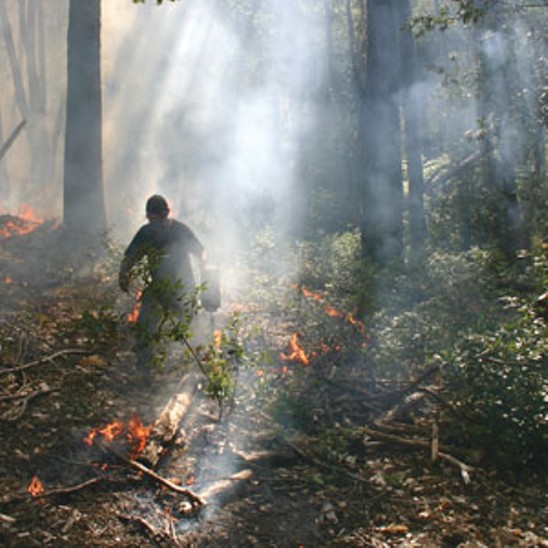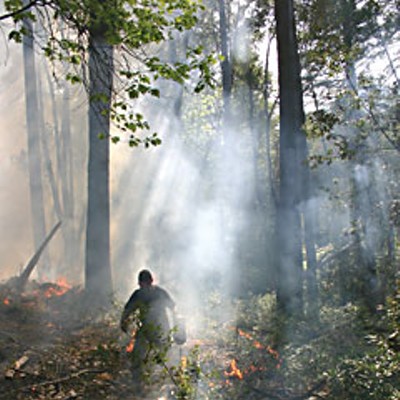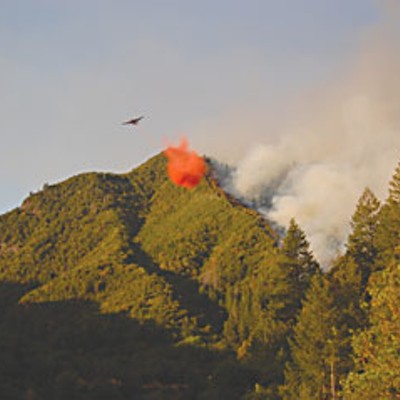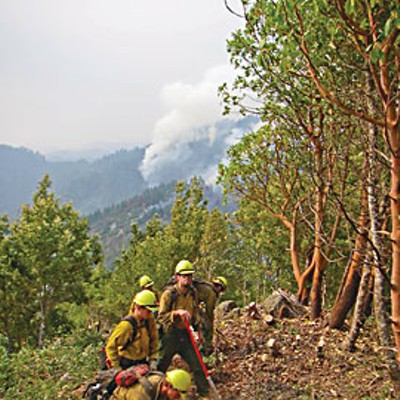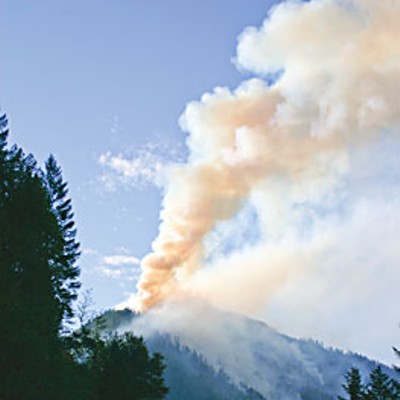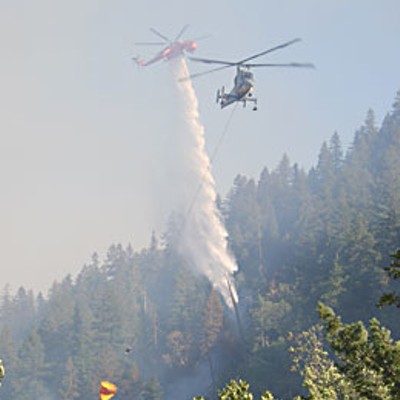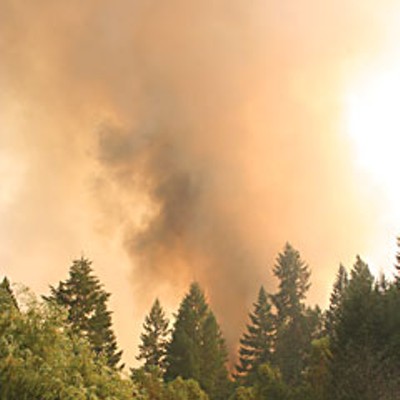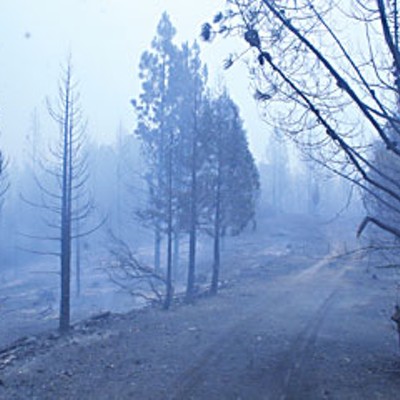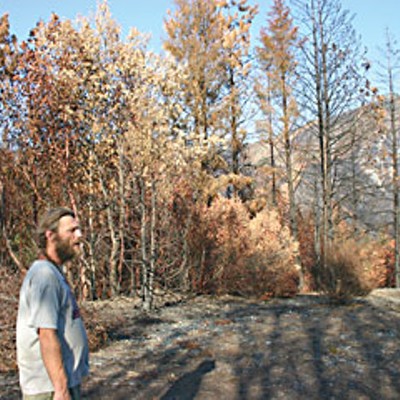Our Fire, Our Fight
A brutal burn season in Klamath country leaves locals grumbling at federal firefighting tactics
By Malcolm Terence[
{
"name": "Top Stories Video Pair",
"insertPoint": "7",
"component": "17087298",
"parentWrapperClass": "fdn-ads-inline-content-block",
"requiredCountToDisplay": "1"
}
]
I don't think I'd ever seen Jim Bennett mad before this year's fires came through his place. And Bennett is no stranger to fire. Before he retired in 1996, he'd worked 32 years as a fireman for the U.S. Forest Service on Salmon River. Fire had burned near his place in 1977. The canyon filled with brush and post-fire logging slash, then burned again in 1987. All this and Jim Bennett, the calmest man on the river, finally got angry after the out-of-town firefighters brought the latest fire down to his backyard this summer.
"The fire team isn't here to put it out. They want to steer it around," he grumbled. "They started the burnout at my place at the wrong time. Three o'clock on a hot afternoon is not a safe time in this drainage. They were in a hurry. They had a goal to get the line burned out up to Forks of Salmon by 1800." (That's 6 p.m. to ordinary clock-watchers.)
He said the bad timing made the burnout ignition so hot that the fires breached a fireline at a water-filled ditch above his place and the crews backed down to save the structures in his small neighborhood. "They tell me, 'You still have your house,'" he said contemptuously. It is not his usual style of speech.
Bennett is chief of the Salmon River Fire and Rescue and no stranger, he explains, to the use of fire to prevent a worse fire. His Karuk father and grandfather told him about how the Indians used to burn late in the fall until the US Forest Service banned the practice. He, himself, remembers how the cowboys used to light fires in the high country meadows when they brought down their herds of cattle in the late fall. "They all knew when to burn. When they stopped that burning, the high meadows became brushfields."
Even before global warming ratcheted fire season up to June, when our big fires of ’77 and ’87 started late in the summer, the Salmon River community had a sort of love-hate attitude toward the out-of-town firefighters. We've loved the protection of our homes and resented the intentional backburning. Sometimes it is successful, and sometimes it triggers catastrophic failures.
I fought fire the first time with Bennett's crew. First afternoon of the 1977 fires, he and two well-trained women were responding to a lightning strike down near the South Fork. I grabbed my shovel, a canteen and a hardhat, then followed them up the hill to the flames. You could do that in those days, even as an amateur.
The women glanced at me with amused smiles and started scraping fireline expertly while Bennett chainsawed fallen trees out of their path. Once I caught my breath and adjusted to the smoke, I realized that the crew worked with great aplomb, unflappable.
Midway through the ’77 fire, which was named the Hog Fire, I was getting a coffee break at the kitchen table of my landlady, Kate George. Nearly 70 years old, Kate was matriarch of the river in those days. Mid-cup, several Forest Service trucks pulled up on the county road and firefighters started piling out.
We wandered up and saw they had fusees, the phosphorous flairs used to start a back burn. "What in the world are you doing?" she yelled.
"Hiya, ma'am. We got orders to back burn above the road here," their crew boss said, big smile.
"Dontcha know that you're on the wrong side of the fireline?" she protested.
"No, no ma'am. We have orders. Don't worry about a thing."
"Well, you call back to get your orders straight and while you do that I'm going to go down and get my rifle." She hustled back down to her cabin.
There was a rush of radio calls and other clamor. What I remember most is the sound of her chambering a round in her weathered carbine when she was halfway back up the path. By the time she got to the road, huffing and puffing, the last of their trucks were leaving, never to be seen again. If she hadn't stopped them, the Hog Fire would have grown far beyond the 50,000 acres it eventually became.
Love-hate relations don't spring up overnight, but Salmon River people have had lots of time.
^^^^^
Not everyone is as angry as Jim Bennett. Ryan Wiegel moved to his midslope place near the mouth of the river two years ago, and he and his partner Jenny Shore say they are grateful for the support they got from the visiting firefighters.
Forest fires move downslope at a lazy stroll but race uphill like they're late for a job interview. That puts midslope houses like Wiegel's at particular risk.
The slope below his neighborhood was brushy and untended, the leftovers of a big fire in 1973 and of salvage logging that followed. Most logging creates a fire hazard. Salvage logging after a fire is famous for it. When the fire started churning below Wiegel's place in early July, the prospects were not good and he called for local help. Thirty locals materialized and they worked alongside a 20-person agency hand crew and a locally based Forest Service fire engine. Other agency people delivered a radio, hose, pumps, sprinklers and portable water tanks. They even brought some extra sets of the fireproof Nomex fire clothes for the locals' protection.
One of the locals Ryan called was Monkey Monk, who the night before had hosted a particularly good birthday party. It was not the kind of morning where people look for work running saws and making dust.
"But Ryan called. We had to go," Monk explained. "Ry lives 90 minutes downriver from me but he's my neighbor. It's a duty. There are maybe 120 active people on the river and we're all neighbors." He was able to coax enough helpers to fill his truck.
Together, the crews cut brush and trees near the structures, especially below them, to reduce the amount of burnable stuff, what firefighters call fuels. From there they began brushing out fuels along an exposed pipeline that delivered high pressure water to the place. If there were tensions between the crews, they quickly got worked out.
Eventually came the day when fire jumped a fireline and went racing up the hill toward Wiegel's property. The agency crews were pulled out for safety. The remaining skeleton crew, a half-dozen locals, had to decide whether they should stay or leave. Will Harling from the Orleans/Somes Bar Fire Safe Council told the assemblage, "Once you decide to stay, you can't leave. The fire will close the exit road when it gets here."
A half-dozen chose to stay.
There was, of course, a back-up safety plan. The previous owners had buried a small steel structure into a hillside years earlier to protect foodstuffs from marauding bears. They had armored it with massive rusted steel tracks from a bulldozer and Wiegel and his confederates had provisioned it with water, food and even oxygen bottles. It looked so much like a military bunker that they called it The Bunker and it was the refuge of last resort.
Wiegel remembers the actual onset of the fire with gap-jaw, wide-eyed respect. "You could hear it roaring up the hill," he said and he made a sound that might be spelled "chuxxx-chuuuxx" -- like clearing your throat but louder and sustained.
"First there was the heat wave," Wiegel said. "It was smoky and it got smokier. The winds came from downslope. The rush of heat was making its own winds, whipping the treetops. It sounded like multiple freight trains. The flames shot up 100 feet tall and I was afraid they'd bend toward us." Beginning firefighters are notorious exaggerators of flame length but veteran observers who watched the scene from a safe remove agree with this estimate.
At this point, an air attack observer in a fixed wing plane above saw the community irregulars in the bright yellow Nomex shirts and radioed down, "There's a fire crew down there."
The radio traffic buzzed as people issued warnings, more urgent than frantic, to the irregulars: "The fire danger is imminent. We advise you to evacuate immediately." The half-dozen defenders held their ground and sprayed the fire hoses on and around the structures with a smoky fervor.
The fire crowned with a fury at a ridge 1,000 feet from the structures, then dropped into a wide natural trough and converted into a hot but well-behaved underburn. The assault of flames was broken.
Soon, the agency crew returned and burned out the pockets between the wildfire and the wet line, a common practice. The worst was over but the fire was not. The next day the fire approached from a flank, and the third day it crept down from above, but the structures were safe and only the exposed waterline was damaged.
^^^^^
Even though Ryan Wiegel was happy his structures were saved, the operation around his place was not without critics.
Will Harling, a former Forest Service employee who now works with the Orleans Fire Safe Council and the Mid Klamath Watershed Council, said other local advisors questioned the choice of location for a key fireline.
Harling said cultural heritage advisors from the Karuk Tribe had cautioned against using the last leg of a steep line from East Peak down to the Salmon River. They said it was destined to fail because of the intense and squirrelly winds so close to the Salmon River's confluence with the Klamath. He heard that Norman Goodwin, a tribal elder, had pointed at the East Peak line on the map and had warned, "You're going to lose it right there." As alternative, they suggested a spur ridge that came down a mile further up river and was more sheltered from canyon winds.
Harling said most visiting teams of firefighters depended on local knowledge, but one of the operations chiefs would look the other way whenever anyone local spoke. "Others sought, or at least entertained our opinions, but that guy was the one who decided much of the on-the-ground strategy."
As it was, Harling said, the experienced hotshot crew ignited the East Peak burnout throughout the day. Because the country was so steep and rugged there was no chance of slowing it mid-operation to play the winds just right. They had to continue lighting through the afternoon to bring it down to the anchor point at the river. Fortunately, the daily, up-canyon winds favored them because it blew their burnout away from their steep fireline back towards the distant but oncoming wildfire. It looked as if they had pulled it off.
But the winds reversed strongly to down-canyon around 10 p.m., a somewhat predictable local event, and all the heat from the ignition "slopped over," in firefighters' graphic parlance for failure.
The line had failed, as Goodwin and others had predicted, and Harling said that now man-introduced fire would come up hill fast to Wiegel's, not the polite downhill low-temperature underburn from above that firefighters hope for.
Goodwin, a lifelong logger and Karuk ceremonial leader who just turned 80, said East Peak was spiritually important to the Karuk people. "East Peak. We call it" -- and he carefully pronounced a polysyllabic place name with several phonemic sounds seldom heard in English. "It means 'Blood running out of the mountain' and it's a good omen if you see it when the sun hits it just right."
He said Karuk people would go there and also to Blue Creek, where another fire is burning and where cultural advisors were also in disagreement with fire managers. Goodwin said that one of the landmarks there -- Doctor Rock -- was revered by several tribes and "that was where they became doctors, the sucking doctors. There were sucking doctors and herb doctors."
He said the sucking doctors were called Patúmko and pronounced it twice, a syllable at a time. They pulled out the malady with their mouths, he explained, and said he had seen it once from a distance when he was a child. It looked, he said, like a small black worm.
He is less nostalgic about this summer's dealings with the fire managers during the three weeks he spent as a cultural heritage advisor. "You couldn't tell them anything. The ridge above Oak Bottom was better terrain, with less erratic winds. Winds on the ridges, especially up high, are unpredictable."
"Maybe they're used to plains country," Goodwin speculated. "They don't know how to put out a fire around here. The backburning is a mistake. Fifteen people lighting fires with such intensity."
"The Indians burned for acorns and for huckleberries, but at the right time of year. When I was a kid, a fire could be put out at 10 acres. Now the Forest Service grows plantations (after clear-cut logging) and they never tend the fuels buildup. It's waiting to explode."
Neither Orleans District Ranger William Rice nor Six Rivers Forest Supervisor Tyrone Kelley responded to e-mailed questions, but Dave Koch, who spent 16 days on the fires with the first visiting management team, was open to talking. Koch usually works in Boise, effectively the world headquarters for American fire management, but he had worked a fire in New Mexico before coming here and worked at the Lime Complex fires in Trinity County since then.
He said the strategic paradigm for handling big fires has shifted since the 1970s, and is still evolving. For a while, he explained, it shifted from outright "suppression" to "let-burn," an approach which got vocabulary upgrades to "prescribed natural fire" and then "wildland fire for resource benefit."
The current approach is called "Appropriate Management Response," and Koch said it was begun last year. In the fires along the Klamath and Salmon Rivers, he said, "It lets us let big parts burn naturally and still protect residences and other valuable resources like archaeological sites, telephone lines and improvements like plantations. There was no way we had resources to put firelines around the whole thing."
He said the joint agency-community response to Wiegel's place was unique because of the high level of community involvement. "That's always a red flag to management because of the risks. Air attack, they were up there in a fixed wing plane. All they saw was a house in the middle of a dense forest so they weren't clued in to the preparedness there. Under different circumstances it could have been dicey, but with all that water show and prep, they could hold it."
Koch recalled the difference of opinions on use of the East Peak line and said, "It had to do with topography, and it seemed in a better position. We rely on the years of experience that our operations people have. Local opinion gets thrown into the mix but we're delegated authority by the Forest Supervisor to do what we need to do. We almost did it. It was a good attempt but it didn't pan out ..."
He says differences of opinion go with the occupation and "the people we get praise from are generally the less informed ones. They're just happy you're there, but in instances where locals have a great deal of knowledge ... the more critical they become, which is good."
He likened many managerial decisions like the location of a fire line or the intensity of a backburn to an art form that has to factor in relative humidity, wind speed, temperature, time of day and what values (such as residences) are at risk.
"It's easy to be a critic after the fact and there are other times when we can be overly aggressive in getting it done," said Koch.
^^^^^
Even before the fires are out, and they will approach 200,000 acres before they are extinguished by winter's rains, there is a clamor for what needs to happen next. The timber industry and the politicians they sponsor have begun to lobby for less regulation of logging. Too many trees make the fires too hot to stop, they argue, and the industry has a ready answer for too many trees. Conservationists and many scientists respond that the bigger trees are themselves fire resistant and their canopy slows the growth of the flash fuel underbrush that spreads fires.
Local planners like Will Harling say the future lies in increased fuels reduction around residences, along critical access/egress routes and in the logged-over land near residences.
I watched last spring as Harling and John Gibbons, a retired USFS burn boss, led a crew from Orleans/Somes Bar Fire Safe Council (OSB FSC) as it lit off an eight-acre underburn near residences to maintain an existing fuelbreak. They started at the top and laid strips of fire gradually downhill on contour. There was much flame and smoke, but an OSB FSC monitor carefully watched temperature, wind speed and relative humidity to keep the operation safe and contained. The burners' work removed the low brush but did little more than singe the conifer and hardwood overstory. Harling says another, similar burn in five years will help keep the structures safe.
One problem, he says, is "when you've got a clearcut on the adjoining Forest Service land, you have to do more work on your place for it to withstand increased fire behavior. We've seen stepped up activity by local volunteers -- 30-some at Wiegel's, 15 at Toz's (another neighborhood that was threatened.) Until our biggest landowner, who owns 95 percent of the land around us, agrees with our priorities, there will be slow progress toward our mutual goals."
At a recent OSB FSC meeting several locals agreed that the agencies needed to spend less on wildfires and more on advance preparation like the spring burn I saw. They agreed that the summer's costs -- over a million dollars a day for months -- were a political leverage, and even discussed approaching Congress to investigate and intervene.
Creek Hanauer, a local resident, started daily e-mailed dispatches to tell what was really happening in the spread of the fires because his neighbors complained that the agencies were non-transparent and even deceptive in their dispatches and weekly public briefings. The agency dispatches, for example, rarely mentioned intentional ignitions or slopovers.
He also complained about the out-of-town management teams that rotate away and are replaced every two or three weeks by a new team of managers, all ready to patronize the locals. "I'm tired of kindergarten every time there's a new team," he said. "People get tired of hearing, 'You know that fire can be a good thing.'"
Creek got a standing ovation from the 20 locals at the OSB FSC meeting for his dispatches. He still lives just upriver on the South Fork Salmon from where Kate George chambered that round in her carbine that afternoon in 1977. She would be proud of his work.
Malcolm Terence lives along the Salmon River, not midslope, and his home has been made defensible for fire thanks to years of work by Salmon River Restoration Council, Orleans/Somes Bar Fire Safe Council, several out-of-town fire crews, his neighbors and his wife. He last fought fire on a Forest Service crew in 1987.
more from the author
-
From Orleans to the Capitol
Spreading Good Fire
- Dec 2, 2021
-
'Given These Songs'
Native singers gather to thank Brian Tripp; he thanks them back
- Jun 17, 2021
-
Fighting Fire with Fire
A devastating wildfire season highlights the need for prescribed burns
- Nov 5, 2020
- More »
Latest in News
Readers also liked…
-
Through Mark Larson's Lens
A local photographer's favorite images of 2022 in Humboldt
- Jan 5, 2023
-
'To Celebrate Our Sovereignty'
Yurok Tribe to host gathering honoring 'ultimate river warrior' on the anniversary of the U.S. Supreme Court ruling that changed everything
- Jun 8, 2023
